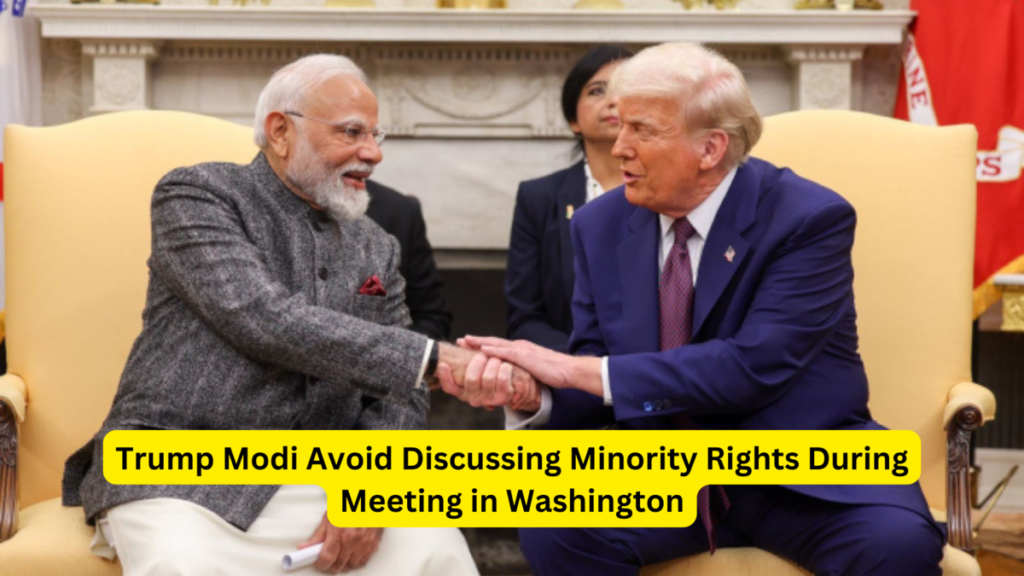Trump Modi Avoid Discussing Minority Rights During Meeting in Washington: When U.S. President Donald Trump and Indian Prime Minister Narendra Modi met in Washington on Thursday, the conversation ranged from weapons sales to trade agreements. However, notably absent from their public remarks was any mention of human rights or the treatment of minorities in India, a topic that has increasingly drawn concern both within the U.S. and internationally. Instead, the leaders focused on strengthening ties in trade and security—issues that continue to be of paramount importance.
It’s not surprising that human rights took a backseat during the meeting. In recent years, discussions on India’s human rights record have become less central in Washington, especially as India has grown in political and economic stature. Experts argue that this trend will continue under Trump’s second presidency, particularly given his interests-based approach to foreign policy.
As the leaders sat together in the White House, their formal remarks and joint press conference made no reference to rights issues, and their online statements were similarly devoid of mention. For instance, when asked about human rights in India, Trump opted to focus on the geopolitical and economic aspects of the relationship, a stance that many have come to expect from his administration.
“Trump is unlikely to take a position on rights issues in India. His foreign policy is deeply rooted in U.S. interests, with little room for considerations like human rights abroad,” said Michael Kugelman, director of the South Asia Institute at the Wilson Center.
While President Joe Biden also maintained strong ties with India during his tenure, his administration did at times criticize human rights violations, especially concerning minorities. Biden’s Secretary of State, Antony Blinken, raised concerns about abuses, while State Department reports on religious freedom regularly highlighted issues in India. However, New Delhi has dismissed these criticisms as “deeply biased.”
Similar Leadership Styles and Shared Perceptions
What stands out in this partnership between Trump and Modi is the similarity in their leadership styles. Both leaders are often described as “strongmen” with a shared worldview, particularly on issues like nationalism and human rights. In fact, experts argue that their common approach strengthens the chemistry between them.
Bajpaee, a senior research fellow at Chatham House, notes that Modi and Trump’s shared perspectives are reflected not just in their political views, but in how they handle criticism of their governance. Both have faced significant scrutiny from human rights groups—Trump for his withdrawal from the U.N. Human Rights Council and his handling of marginalized groups in the U.S., and Modi for the treatment of minorities in India.
Human Rights Watch and Amnesty International have long raised concerns about the treatment of minorities under Modi’s government, including rising hate speech, the controversial Citizenship Amendment Act, anti-conversion laws, and the revocation of Kashmir’s special status. While Modi defends his policies, insisting they benefit all citizens, many critics believe that such measures disproportionately target Muslim communities.
Focusing on Immigration and Economic Partnerships
Interestingly, one topic that did receive significant attention during the meeting was immigration. Trump, whose administration has emphasized the handling of illegal immigration, expressed a commitment to controlling border security, while Modi lobbied for expanded U.S. visa opportunities for skilled professionals. The H-1B visa program, which benefits thousands of Indian workers annually, has been a focal point in U.S.-India relations.
Modi also stressed the importance of addressing human trafficking, a topic he linked to illegal immigration, noting that India was “fully prepared” to take back any Indian citizens found to be living in the U.S. illegally.
Another point of contention that has recently emerged in U.S.-India relations is the issue of Sikh separatism. The U.S. has expressed concern over India’s efforts to target Sikh separatists abroad, particularly in the U.S. Kugelman pointed out that with Trump’s nationalist views, it’s unlikely that he would push India to ease its stance on this matter. The extradition of an individual accused in the 2008 Mumbai attacks is an example of U.S.-India collaboration, but on matters like these, the leaders’ approaches differ.
Conclusion: Strong Ties Despite Differences
Despite the absence of human rights discussions, the meeting between Trump and Modi highlights the growing strength of U.S.-India relations, particularly in trade and security. Both countries appear committed to pursuing shared goals, even as they navigate sensitive issues like immigration and minority rights. As the global political landscape continues to evolve, these two leaders will likely continue to build on their strategic partnership—albeit without tackling the more uncomfortable topics of human rights and minority protections.
As we move forward, it will be interesting to see whether future U.S. administrations will take a more assertive stance on these human rights issues, or whether, as in this case, geopolitical and economic priorities will overshadow concerns about minority abuses.
Additional Productivity-Enhancing Tools in Diplomacy and International Relations
In today’s fast-paced political world, leaders like Trump and Modi increasingly rely on various productivity tools to streamline decision-making and enhance diplomatic efforts. Tools like real-time data analytics and AI-driven policy analysis have become essential in making informed, strategic decisions on international issues. These technologies can process massive amounts of data quickly, helping leaders focus on high-priority areas like trade, security, and economic cooperation.
Furthermore, digital communication platforms and collaborative tools, such as secure messaging systems and shared databases, allow leaders and diplomats to maintain continuous communication, even across time zones. This can significantly increase productivity by reducing delays and improving response times to global events.
